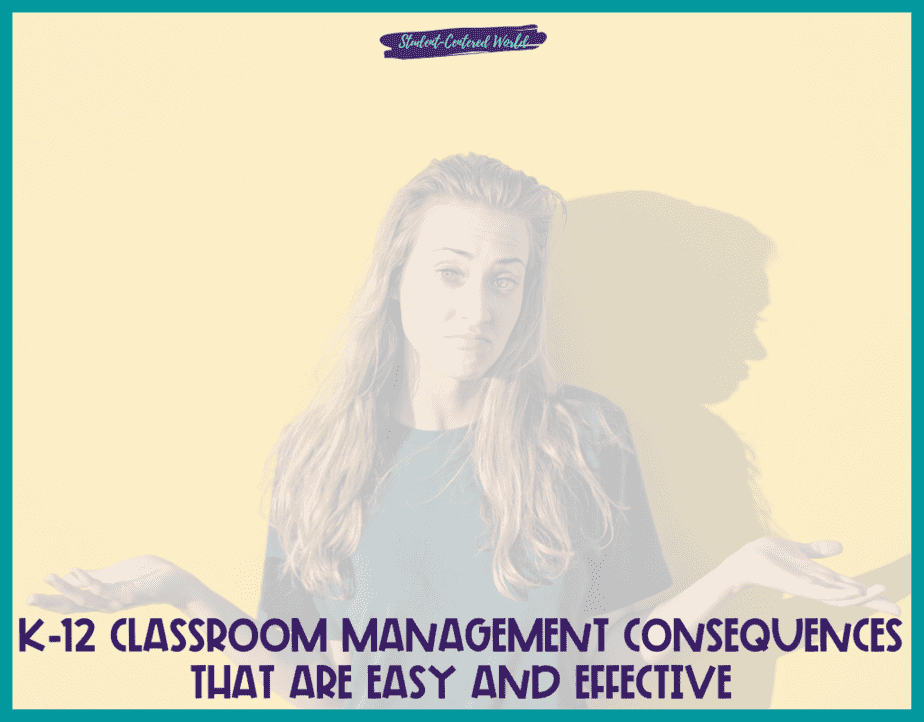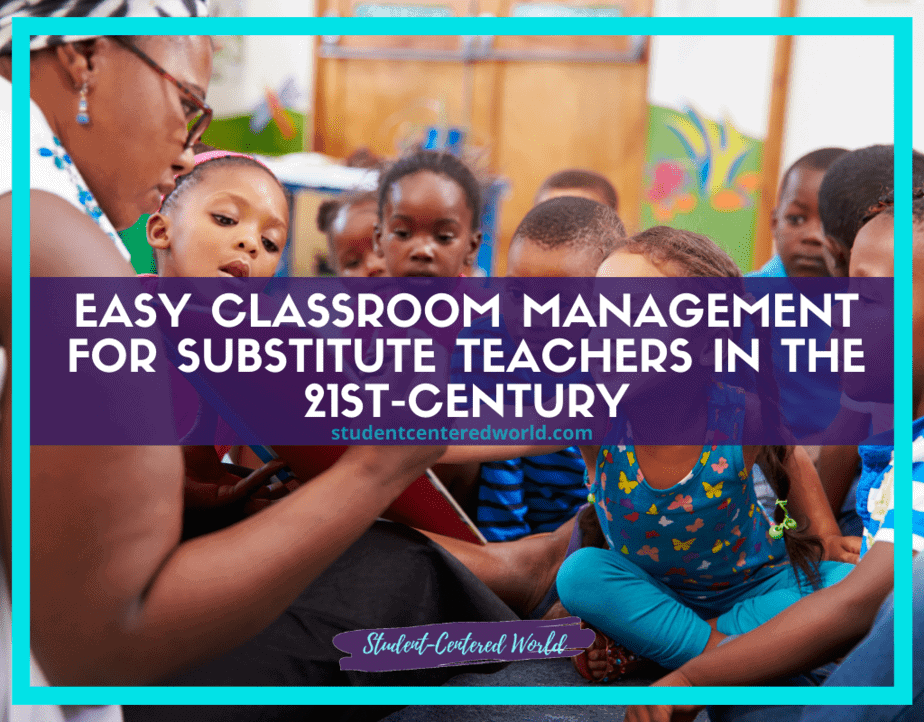K-12 Classroom Management Consequences that are Easy and Effective
With student-centered classroom management, the idea is that the more your students’ buy into the process, the fewer discipline issues you will have overall. Though this is certainly the case (and I personally have proven it in situations time and time again through my own classroom and those teachers whom I’ve worked with), sometimes there does need to be classroom management consequences, especially in those early stages of understanding what behavior is expected to be the cultural norm of your classroom.
Classroom management consequences don’t necessarily have to be supremely negative or punitive as many immediately think. Instead, classroom management consequences should be directly related to the behavior at hand.
I truly believe in natural consequences. If we are constantly harping on, “…but that’s how the real world works”, natural consequences are the best way to establish this in our students’ minds.
What are Natural Consequences?
When looking at classroom management consequences, natural consequences seem to have the most bang for their buck. In definition, natural consequences are the direct results of a student’s choices. If a student chooses not to do their work, then that will be the grades they receive. If a student fails to turn in an assignment on time, then he or she may have to stay after school for an extra period of time or take a zero.
Personally, I always made the student come in on their own time to complete assignments that they missed. So now, not only do they still have to complete the assignment, but they have to take extra time to schedule and sit with me to get it done.
The best part about natural consequences is that it’s up to the student. There’s nothing the teacher has to do, it’s all in the hands of the student. If a student chooses not to listen and follow along with a discussion, then no harm done – but they won’t learn anything either!

Why Use Natural Consequences?
Natural consequences have been around for many years. They are a great way to teach students that the choices they make truly do have consequences and it is up to them as individuals to determine what those consequences will be. By using natural consequences, we avoid taking away from instructional time motivating our students with negative disciplinary actions, we let them learn from their own mistakes, and we actually pave the way for the real world to come full circle.
Natural consequences occur without the involvement of adults and they affect everyone, even bystanders and observers!
Natural consequences are exactly what we would expect to happen if we made a poor choice. For example, writing all over one’s desk with a marker will likely result in stains on the desk for quite some time after the marker is put away. If a child decides to leave their seat and run around the room with a classmate, there is a chance they will accidentally trip and fall resulting in some bumps and bruises. Choosing not to use your “inside voice” in a library results in shushes from other visitors or even loss of privileges for future trips to the library.
These are only a few examples of natural consequences, but there are so many more! Perhaps the best part about them is how easy they can be to implement with very little effort on our part.
As teachers, we know students learn by doing – the more hands-on and engaging experiences we provide, the better. When students are able to learn from their own mistakes, they are typically more likely to remember the lesson if it somehow plays into what they are learning in class.
As you can imagine, natural consequences are extremely beneficial in this regard.
Since students are often required to complete choice-making activities in class, providing natural consequences for poor choices can be very helpful when it comes time to grade the activity. For example, if a student is choosing which type of cell they would like to create instead of completing an assignment about the properties of plant cells, they must consider their choice carefully because they will likely have to explain why they chose what they did. If the student’s explanation is not sufficient, this would be a great opportunity to explain why their answer was incorrect and provide them with an opportunity to revise it based on the feedback provided – all through the use of natural consequences!
I do things the way I do them because they work! Natural consequences are a great alternative to taking away instructional time or reinforcing negative behaviors through disciplinary actions. They allow children to learn from their own mistakes and pave the way for what real-world consequences could possibly be. When you give your students the opportunity to make choices, natural consequences are a great way to help them follow through with those choices or improve upon them through revision. I would say that is definitely worth at least trying!

How To Implement Natural Consequences
First, you must realize that natural consequences are not an excuse to let your students do whatever they want. Students need to understand that there is a clear distinction between what’s right and what’s wrong in the classroom, which is very much part of the classroom management process. They also need to understand that there is a “time and place” for everything in life, whether it be lunchtime, recess time, or just free time in general.
In order to further establish this idea of natural consequences being the direct result of students’ choices – you must let your students know ahead of time what consequences will be in store if they continue with their behavior. Make this part of your classroom management procedures and let students know that you will not tolerate certain behaviors in your room.
This is something that will start naturally being policed by the other students in the classroom, too. If you establish an environment where consequences are natural – then you will not see the same behaviors appear in your classroom that you used to see with traditional consequences.
This is NOT letting students do whatever they want and expecting someone else (a teacher, a parent, etc.) to come to swoop in and make them do their work. This is helping students recognize WHY they need to do their work and making them see that it is something they can CHOOSE to do.
I cannot stress this enough – if you put the responsibility of students’ success or failure into someone else’s hands (ie “If mommy/daddy doesn’t force me to do my work, then I won’t do it”), you are teaching students that they cannot make good choices on their own.
If you start this process now, your students will be more responsible and self-reliant individuals for the rest of their lives.
Finding Appropriate Classroom Management Consequences
It is also necessary to have the “punishment fit the crime”. Taking away a privilege that has no correlation to the action (or inaction) that took place doesn’t really have the same effect. Instead, it turns into more of a power struggle between adult and child.
Now, of course, there are some that feel that a hierarchy does need to be understood, and while that may be the case, there are different ways to go about this so respect is earned, reciprocated, and yet understood as opposed to “this is going to happen because I said so”.
For example, I had a student who was repeatedly coming late to class one day after another, so I made her leave her bag at my desk for three days following. The more direct approach of taking something away is always an option as well if you have misbehaving students acting out by throwing objects or purposefully distracting others who are trying to learn. Students (just like us) get frustrated and want attention, so sometimes it’s the simple act of taking away something they value temporarily that can affect change in their behavior.
Classroom management consequences do not have to be harsh; they simply need to be relevant to the infraction itself – and if there is a pattern of behavior, it needs to be dealt with in such a manner so as not to repeat itself for the duration of the school year.
Classroom management consequences can go hand-in-hand with classroom management techniques and/or policies, but they should also be immediate, deliberate, and consistent each time misbehavior occurs.
Classroom management consequences may be thought of as negative at first glance, but when properly used in conjunction with positive classroom management techniques can foster a greater relationship between teacher and student while also helping the students learn self-control.
As another example, suppose Johnny is loitering in line while waiting to be allowed into class after lunch. The teacher immediately calls for him to get back into his spot in line, but Johnny continuously disregards this direction, which then leads to him being left out of the current discussion.
What are the classroom management consequences in this scenario that make sense?
There are a number of ways to deal with students who continue to disregard directions and disrupt the process for others.
-The teacher could take Johnny’s name down, noting that there will be additional consequences when the next class period begins.
-The teacher could also hold Johnny back after school in order to discuss his behavior and its consequences.
-The teacher could also send Johnny to the office, with a note for the secretary to notify parents of the disruption (depending on your school’s protocol and expectations for this).
Each of these options would be considered appropriate consequences because they are directly related to Johnny’s decision-making and disregard for rules or directions that have been set before him. In this scenario, as in many classroom management situations, once Johnny understood what was expected of him, he would naturally behave differently the next time.
Once the classroom management consequences have been established, there must be a plan by which such consequences are applied. If a student chooses to disrupt the class, then he or she may end up being sent to the office or other designated area, or given an assignment. This would be considered a form of consequence because the student was removed from the school environment for several minutes to complete work in order to bring him/her back into compliance with rules and expectations. The teacher should document these situations as well following the application of consequences so that there is no question about what occurred.
Classroom management consequences are often temporary but can be permanent depending upon the student’s behavior, the severity of the incident, and the status of their overall record.

What is an Inappropriate Classroom Management Consequence?
-Johnny was told to “sit out” for recess for a day because they were busy with other things and there wasn’t any time to work on the assignment at that time.
-Johnny’s mother was called because he was acting out during his math class.
-Johnny didn’t have any friends, so nobody wanted to sit by him during lunch.
In all of these situations, punishment is not an appropriate classroom management consequence because it isn’t directly related to Johnny’s specific behavior in class.
Sit out of recess is related to Johnny’s behavior, but does not have a direct link to the class in question. Additionally, punishment is meant to be used for severe misbehavior and/or repeat offenses, neither of which occurred here. Calling mom simply because he was acting out during math class is similar; this action wasn’t directly related to the incident and there were no other steps taken by the teacher to provide consequences for Johnny’s behavior. Having nobody sit with him during lunch is also unrelated and would only serve as punishment, not a consequence meant to help him understand why what he did was wrong.
Classroom management consequences should only be used when they are directly related to the student’s behavior and should be done in a way that ensures Johnny understands the connection between his actions and the consequence.
One final thing to keep in mind is that there should NEVER be any discussion or negotiation about classroom management consequences – these simply need to happen. In Johnny’s case, the teacher didn’t need to say what would happen if he continued to disrupt the class. He was well-aware of this already and has likely experienced it before!
Stop Driving the Teacher Struggle Bus
Are you struggling with student engagement, apathy, or keeping your class on track?
💫💫 There’s hope! 💫💫
Join my free teacher workshop “Choosing Choice” and in just 60 minutes, you’ll craft a practical plan to revitalize your teaching. Discover the magic of student choice in boosting engagement, gain quick implementation ideas, and explore strategies for year-long success.
Unlike overwhelming workshops, my approach guides you in real-time, providing more classroom options, reducing stress, and giving you more personal time.
Plus, you’ll earn a 1-hour professional development certificate and have 7 days of access.
Don’t miss this chance to transform your teaching; click below to secure your spot now!






